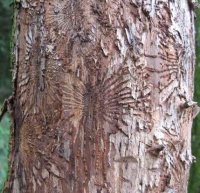AgEBB-MU CAFNR Extension
Green Horizons
Volume 24, Number 1
Winter 2020
Urban Forestry
Elms in America
By Meridith Perkins & Cory Knoblauch | Forest ReLeaf of Missouri
 |
Bark of elm tree infected with DED, Image from: https://www.kansasforests.org/ |
It has been 90 years since the Dutch elm disease (DED) first arrived in the United States. At that time native American elm trees (Ulmus americana) grew in great numbers across the forested landscape as well as the urban core. The American elm proved tolerant to the challenges of city living and became the go-to tree for park strip plantings along streets. The large, vase shaped elm canopy created green corridors and grew to define neighborhoods everywhere. However, when the United States began importing wood after World War I, the DED fungus (Ceratocystis ulmi) and the European elm bark beetle (Scolytus multistriatus) vector came along for the ride. Within a few decades hundreds of thousands of American elm trees were dying across the USA. There was and is still no effective treatment for trees once they are infected with DED. Few stately American elms remain in Missouri and many of these are treated annually with a preventative fungicide to keep the disease at bay.
After all this, people are not ready to give up on elms! Researchers continue working to isolate DED resistant American elm cultivars and develop elm hybrids that mimic those iconic American elm traits. If you are looking for an elm tree for your home landscape, consider:
- Princeton (Ulmus americana 'Princeton') is one of the most common American elm cultivars. It has good DED resistance and maintains a fairly upright, vase-shaped form.
- Frontier elm (Ulmus minor x parvifolia) has good resistance to Dutch elm, will reach 30 to 40ft tall at maturity and does best in hardiness zones 4-7. The Frontier elm has been known to live for up to 80 years and is slow growing. This hybrid elm is the rare mixing of a spring and fall flowering elm that exhibits beautiful purple color in the fall.
- Accolade elm (Ulmus davidiana var. japonica 'Morton') is derived from a hybrid elm that grows very rapidly and can reach 50 ft tall. It is able to tolerate dry soil conditions and drought, making it a hardy variety for the urban environment.
- Lacebark elm (Ulmus parvifolia) or Chinese elm has unusual mottled bark, and smaller leaves than American elm. It is an Asian elm that reaches 50 ft in height, with good DED resistance. Lacebark elm makes a great landscape tree because it is tough and tolerates harsh conditions.
- Bosque elm (Ulmus parvifolia 'Bosque') is renowned for its extreme drought tolerance and can withstand the hottest summer temps. Native to Asia, this specimen can reach up to 70 ft and has nice purple foliage in the fall.
- Caucasian elm (Zelkova carpinifolia) is an Asian species related to the more commonly available Japanese zelkova (Zelkova serrata); both are highly resistant to DED. Caucasian elm reaches heights of 60 ft and presents a nice vase form at maturity. This tree does best in rich, well drained soils. Zelkova has a nice yellow color in the fall.
 |
Image from: https://moonnurseries.com/ |
 |
Image from: https://plants.oaklandnursery.com/ |
 |
Image from: https://landscapeplants.oregonstate.edu/ |
 |
Image from: http://plants.wasconursery.com/ |
 |
Image from: https://moonnurseries.com/ |
 |
Image from: https://www.vdberk.com/ |
 |
Left: American Elm, Right: White Ash Leaves Source: https://nature.mdc.mo.gov/
 |
 |
White Ash Trees, |
Many elms resistant to DED still suffer from black leaf spot, phytophthora root rot, Japanese beetle, bark beetle, and weak wood structure. For this reason, over the past 50 years a favorite elm tree replacement has been ash. Streets previously lined with American elm were planted with monocultures of green ash (Fraxinus pennsylvanica) or white ash (Fraxinus americana). Now, we are losing this critical tree canopy to the devastating impact of the emerald ash borer!
What we have learned from decades of tree planting investments is that species diversity is the key to a resilient urban forest canopy. Neighborhoods should have a combination of trees from different species, genus, and families. Some underrepresented native trees that may be appropriate for elm tree replacement include: hackberry, river birch, shumard oak, black gum, and bald cypress. Forest ReLeaf of Missouri has these tree species available for spring planting projects through our free tree giveaway program or private sales. Apply in February at www.moreleaf.org.
